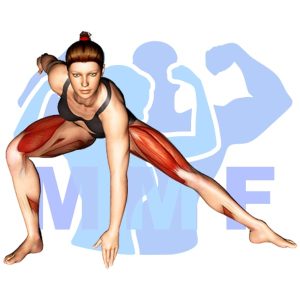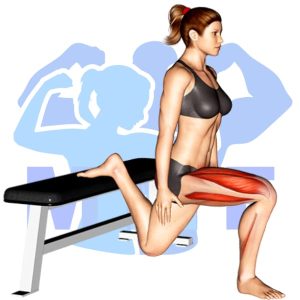Have you been struggling with weak and underdeveloped legs lately? Are you finding it challenging to find the time or equipment to get in a proper leg workout? One exercise that you may not have tried yet are resistance band single leg extensions. It’s common to feel overwhelmed with the number of exercises and equipment available, making it easy to overlook seemingly simple yet effective ones like this. Don’t worry; we understand how it can be a struggle, which is why we are here to guide and support you in your fitness journey. In this blog post, we will be sharing the benefits, steps, and variations of resistance band single leg extensions to help you achieve stronger and more defined legs in no time.
Resistance Band Single Leg Extensions Summary
- Primary Muscles: Quadriceps
- Secondary Muscles: Iliopsoas, Sartorius, and Tensor Fasciae Latae
- Equipment: Resistance Band and Door Anchor
- Mechanics Type: Isolation
- Force: Push
- Utility: Auxiliary

Resistance Band Single Leg Extensions Instructions
- Connect each end of the resistance bands to each one of your ankles and hook up the center of the band to a door anchor around the bottom of the door.
- Step out away from the anchor point until the band is tight. You may want to grab a chair for balance, or you can use a wall if there is one close.
- Additionally, you can tighten the band more by wrapping it around your support leg.
- Next, raise your leg up in front of you with your knee bent just enough that when you straighten your knee, your foot will not touch the ground.
- You can put a broomstick or rod under your knee and brace it with your hand. The bar should cross in front of your support leg and behind your active leg, although this is not necessary.
- Now that you are in position, extend your leg by bending only at your knee.
- Focus on flexing your quad and hold for a second.
- Finally, bend you leg back to the starting position.
- Repeat for your 8-12 reps and then switch legs.
Video Tutorial
Resistance Band Single Leg Extensions Muscles
Target (Agonist)
Synergists
- Iliopsoas
- Sartorius
- Tensor Fasciae Latae
Dynamic Stabilizers
- None
Stabilizers
- Gluteus Medius
- Gluteus Minimus
- Obliques
- Quadratus lumborum
- Rectus Abdominis
Antagonist Stabilizers
- None

Benefits of Resistance Band Single Leg Extensions
The Resistance Band Single Leg Extension is an excellent exercise for strengthening the quadriceps muscle. It can be done with minimal equipment and is a great way to target the quads without putting stress on the knees. This exercise is also great for improving balance and coordination, as well as building strength in the glutes and core. With proper form, this exercise can be done with light resistance, making it suitable for all fitness levels. It is an effective way to strengthen the quads without overloading them, allowing them to develop gradually and safely.
Tips for Performing Resistance Band Single Leg Extensions
If you would like to get the greatest gains, stick to these straightforward tips. Similarly, if you would like to minimize the chance of injuries, follow these tips.
- Double Up Bands To Raise The Workout. If you find yourself easily doing 12 or more reps every exercise, then you need to raise the level of resistance. You can either do this by elongating the band further at the outset of the movement or by including more bands. The favored technique is to add more bands since it is conveniently repeatable to get a similar resistance on every workout.
- Perform The Appropriate Amount Of Sets Along With Rest. Your target at first ought to be to do 3 sets to near failure. In reality, you can raise to 5 sets. If your muscle tissue isn’t tired at the conclusion of 3 – 5, something should change. Initally, you can increase the resistance to make each repetition harder. Additionally, you can cut down on the rest time in between each set.
- Maintain Your Abs Tight. For most exercises, you need to support your back bone by flexing your core to raise your inner pressure near your spinal column.
Benefits and Tips Video
Frequent Mistakes To Avoid
You need to keep from making these standard mistakes to ensure nice form and improved tonning. Moreover
- Don’t Allow Yourself To Cheat. In the majority of the time, cheating is employing momentum as a substitute for the strength of your target muscle tissue. Once in a while, some cheating on your last rep can be great to overload your muscle, but not for more than a couple of reps.
- Stop Yourself From Using Too Little or Too Much Tension. Too little, and you will not be adequately using your agonist (target) muscle, a large amount, and you will probably cheat. Ensure that you can conduct between 8-12 reps with proper form.
Find More Resistance Band Exercises Here
Variations and Complementary Exercises
The exercise Resistance Band Single Leg Extensions is a great way to strengthen and tone the legs, but it’s always important to mix up your routine. Here are some variations, complementary, or alternative exercises that work similar muscles as the Resistance Band Single Leg Extensions.
Resistance Band Squats

Resistance Band Squats are an excellent complementary or alternative exercise to Resistance Band Single Leg Extensions. This exercise works your glutes, quads, hamstrings, and core muscles as you sit back and down into a squatting position while maintaining tension on the band. The range of motion can be adjusted by changing your stance and the amount of tension on the band. This exercise will help strengthen the muscles used in the single leg extensions, and can help improve balance and stability.
Plyo Side Lunge

The Plyo Side Lunge is a great complementary or alternative exercise to Resistance Band Single Leg Extensions. This exercise works the glutes, quads, hamstrings, and core and is performed by standing with feet slightly wider than hip-width apart and then stepping out to the side with one leg and lowering into a lunge. The arms should be extended out for balance. To make it more challenging, jump out to the side when stepping and pause for a few seconds at the bottom of the lunge before pushing off and returning to the starting position. This exercise is great for developing explosive power, balance, and stability in the lower body.
Half Squat

The Half Squat is a great complementary or alternative exercise to Resistance Band Single Leg Extensions. This exercise helps strengthen your glutes, quads, and hamstrings, as well as improving overall balance and coordination. It also allows for a greater range of motion than the Resistance Band Single Leg Extensions, as you are able to squat down deeper. It can be done with or without weights, depending on the difficulty you’re looking for. The Half Squat is a great exercise to incorporate into your workouts for additional lower body strength and stability.
Check Out These Top Resistance Band Exercises
Bulgarian Split Squat

The Bulgarian Split Squat is a great exercise that complements the Resistance Band Single Leg Extension. This exercise targets the same muscles as the Resistance Band Single Leg Extension, while also working the stabilizing muscles in the hips and core. The Bulgarian Split Squat requires the individual to perform a single-leg squat while holding a weight, or bodyweight, on the back leg. This unilateral movement is great for developing balance and strength in each leg individually. It also helps to prevent muscular imbalances between the legs. Additionally, the Bulgarian Split Squat can be modified to increase or decrease the level of difficulty to match an individual’s strength and fitness level.
Dumbbell Split Squat

The Dumbbell Split Squat is a great complement or alternative to the Resistance Band Single Leg Extension. It is an excellent lower body exercise that works the glutes, quads, and hamstrings, as well as the stabilizing muscles in the hips and core. To perform the exercise, stand with one foot placed forward and one back, holding a dumbbell in each hand. Lower your body until both legs are bent at a 90 degree angle, then push yourself back up to the starting position. This exercise helps to strengthen the lower body while also increasing stability and balance.
Dumbbell Side Lunge

Dumbbell Side Lunge is an excellent complementary or alternative exercise to Resistance Band Single Leg Extensions, as it focuses on building strength in the same muscles. The Dumbbell Side Lunge works the quads, glutes, hamstrings, and calves while also targeting the core and lower back. To perform the exercise, you start by standing with feet hip-width apart and a dumbbell in each hand. Then, you take a large step to the side, bending the knee and dropping your hips until the knee of your back leg almost touches the floor. You then push off the heel of your front foot to return to the starting position and repeat on the other side. This exercise can be done for reps or for time, making it a great way to mix up your routine and challenge your lower body muscles.
Find More Legs Exercises Here
Opposing Complementary Exercises
Opposing muscle groups are an important part of any exercise routine. To complement the exercise Resistance Band Single Leg Extensions, the following exercises target the opposing muscles and will help you to achieve optimal balance and symmetry in your workout.
Resistance Band Single Leg Curls

Resistance Band Single Leg Curls are a great exercise to pair with Resistance Band Single Leg Extensions to target the opposing muscle groups. The resistance band single leg curl works the hamstrings, which is the opposing muscle group to the quads that are worked in the single leg extension. This pairing helps to ensure that both muscle groups are properly trained and strengthened, allowing for a balanced workout. The resistance band single leg curl also helps to improve stability and balance, while strengthening the core muscles as well.
Resistance Band Leg Curls

Resistance Band Leg Curls are an excellent complementary exercise to Resistance Band Single Leg Extensions. Resistance Band Leg Curls target the hamstrings, which are the opposing muscle group to the quadriceps targeted by Resistance Band Single Leg Extensions. Resistance Band Leg Curls involve lying on your back and looping a resistance band around your ankles, then slowly curling your legs up toward your body, engaging your hamstrings. This exercise helps to build strength and balance in the opposing muscle groups, improving overall performance.
Smith Machine Single Leg Deadlift

The Smith Machine Single Leg Deadlift is a great way to complement the Resistance Band Single Leg Extension exercise. This exercise works the opposing muscle group, allowing for a balanced lower body workout. The Smith Machine Single Leg Deadlift focuses on the hamstrings, glutes, and lower back muscles, while the Resistance Band Single Leg Extension works the quadriceps and hip flexors. By performing both exercises, you will get a full lower body workout that will help strengthen and tone your legs and glutes.
Take Your Leg Workouts to New Heights with Resistance Band Single Leg Extensions!
If you’re looking to add some intensity to your leg workouts, resistance band single leg extensions are a great way to do it. By using resistance bands, you can increase the resistance as you extend your leg, providing a burn that bodyweight exercises alone cannot achieve. The single leg aspect of the exercise helps to build stability, balance, and strength in each leg individually. Plus, resistance band single leg extensions can be done virtually anywhere – at home, in the gym, or even outdoors. If you haven’t tried this exercise before, give it a shot and take your leg workouts to the next level.
References: Wikipedia | ExRx.net | PubMed.gov | Comprehensive List of Legs Resistance Band Exercises

